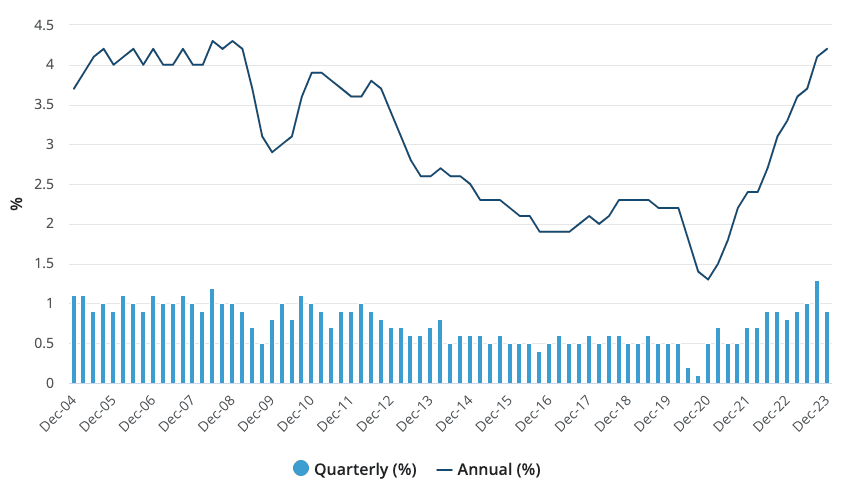Australian Dollar: Hot Wages
- Written by: Gary Howes
-

Image © Adobe Images
Australian wage increases proved a little hotter than the market expected in the final quarter of 2023, a development that should ensure the Reserve Bank of Australia (RBA) maintains a cautious approach when considering interest rate cuts.
The Australian Dollar was the day's second-best performing major currency after the ABS reported the quarter-on-quarter increase in the wage index was 0.9% in Q4, taking the annual increase to 4.2%, which exceeded expectations for 4.1%.
Wage increases are running at levels inconsistent with the RBA's aim of bringing inflation back to the 2.0% level. Still, policymakers will take some positives from the fact that the quarterly increase has fallen from Q3's 1.3% gain.
Above: Aussie wages are down from Q3's blistering hot advance but remain elevated. Source: ABS.
The RBA's minutes for the February meeting said the central bank could raise interest rates again if warranted.
"We don't think today’s data will sway the RBA’s thinking, and we still see the cash rate on hold at 4.35% until November," says Catherine Birch, an economist at ANZ Bank. A November rate cut would wrong-foot markets that are currently priced for an RBA rate cut occurring around June.
If Birch and colleagues are correct, market pricing will have to adjust in a manner that will potentially firm the Australian Dollar.
Following the wage numbers, we see the Pound to Australian Dollar exchange rate is lower by 0.18% at 1.9237, and the Euro to Australian Dollar is down by a similar margin at 1.6463. The Aussie is up a quarter of a per cent against the U.S. Dollar at 0.6566.
ANZ says the RBA will maintain vigilance as economists there expect wage growth will remain a little above 4% y/y in the first half of 2024 before slowing gradually in the second half.
The figures also confirm annual real wage growth turned positive for the first time since Q1 2021 (+0.1% y/y). "Falling inflation, elevated nominal wage growth, and upcoming tax and rate cuts will support households in 2024," says Birch.






